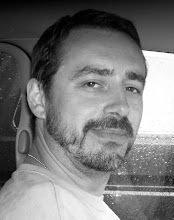 Working from a literate script by James Vanderbilt, director David Fincher has crafted an absorbing drama with his latest film Zodiac. This is not a serial killer film, but a movie about the investigation itself and its effects on those who were obsessed with finding the Zodiac killer in San Francisco. It’s fascinating, textured, compelling stuff, with great central performances by Jake Gyllenhaal, Robert Downey Jr., and Mark Ruffalo.
Working from a literate script by James Vanderbilt, director David Fincher has crafted an absorbing drama with his latest film Zodiac. This is not a serial killer film, but a movie about the investigation itself and its effects on those who were obsessed with finding the Zodiac killer in San Francisco. It’s fascinating, textured, compelling stuff, with great central performances by Jake Gyllenhaal, Robert Downey Jr., and Mark Ruffalo.Gyllenhaal plays Robert Graysmith (the real-life author of the book that is one of the key sources for the screenplay), an editorial cartoonist who finds himself drawn into an unofficial search of his own for Zodiac. Downey Jr. is Paul Avery, alcoholic crime writer at the same newspaper, playing the part with the obvious relish of a solid character actor. And Ruffalo is magnetic, believable, and borderline tragic as Inspector Toshi, doggedly pursuing multiple leads and blind allies for many years. The narrative centres around these three individuals, and how they cope with the bleak, lengthy, and ultimately unsolved mystery of the Zodiac killer, who haunted the San Francisco area starting in 1966. The killer writes letters to the local newspapers that include coded messages and begins taunting the police, launching the labyrinthine investigation that spans three decades. The film details the complexity of the search for the Zodiac in convincing, but never overwhelming, detail, and emphasizes the grueling passage of time with the use of context-setting subtitles that show the place and date in relation to the previous scene (“2 weeks later”, for example). The agonizing pace of the investigation, the frustration of the dead-end leads, and the emotional toll this took on the principal investigators is brilliantly portrayed in the film.
Zodiac’s attention to detail and historical accuracy is remarkable. Even a brief review of some of the accounts of the crimes reveals that the film sticks closely to the facts. In the first murder, for example, the killer returns to the car after shooting the victims, and shoots them again. (For a fascinating review of the case, see http://www.crimelibrary.com/serial_killers/notorious/zodiac/river_1.html). The production design, set decoration, and costume design effectively recreate a period ’70s setting, without loudly announcing the fact. There is undoubtedly a subtle, complex art to creating a period feel, especially one set in this decade, that does not garishly distract from the story.
 Though this is first and foremost a character drama and a mystery, and not a suspense thriller, the actual Zodiac killings are shown and are frightening in their bleak authenticity. Fincher shoots these sequences from the point of view of the victims, with ominous close and medium shots, allowing tension to quietly build before exploding into shock at the stark, cold brutality of the murders.
Though this is first and foremost a character drama and a mystery, and not a suspense thriller, the actual Zodiac killings are shown and are frightening in their bleak authenticity. Fincher shoots these sequences from the point of view of the victims, with ominous close and medium shots, allowing tension to quietly build before exploding into shock at the stark, cold brutality of the murders.Zodiac features a brilliant artistic use of digital effects. Using digital camera moves by Matte World Digital, there are several aerial shots of 1970s San Francisco that are beautifully rendered and detailed, giving a genuine sense of place. Digital effects are used to recreate a period cityscape, with historically accurate buildings and freeway. The panoptic matte shots are so incredibly detailed and constructed that they don’t announce themselves as effects shots. They just add to the authentic setting and help advance the narrative and thematic elements. In one astonishing sequence--digitally rendered--the camera follows a Yellow Cab on the streets of the city, appearing to be locked into place on the car’s orientation, shifting as the vehicle turns street corners. Another inspired sequence shows the time lapsed construction of the Transamerica building, a lithe pyramidal structure that assembles itself before our eyes, giving the feel of time passing on in the city as the Zodiac investigation proceeds ever onwards. Perhaps the most unique visual effect is a short sequence that shows the mountain of clues, leads, and dead ends that accumulate on the case by having the characters walk through settings that are draped and ornamented with written text from the case files. Though it’s not an effects picture per se, the effects team on Zodiac has done stellar work, in a signature example of how to use digital effects in the service of story.
Zodiac is not for those in search of cheap thrills. It is a complex, intelligent character drama, and an often remarkable document of one of the great unsolved serial murder investigations.
---
Directed by David Fincher
Written by James Vanderbilt
Based on the book by Robert Graysmith
Starring:
Jake Gyllenhaal...Robert Graysmith
Mark Ruffalo...Inspector David Toschi
Anthony Edwards...Inspector William Armstrong
Robert Downey Jr....Paul Avery
Brian Cox...Melvin Belli
John Carroll Lynch...Arthur Leigh Allen
Chloë Sevigny...Melanie

No comments:
Post a Comment